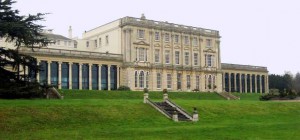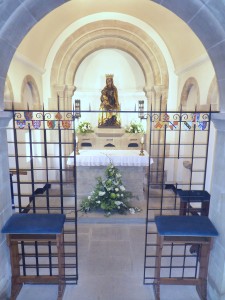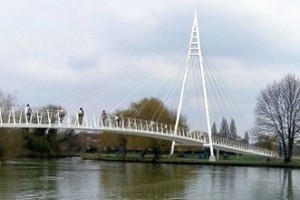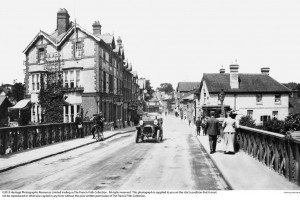History
The Original Caversham
Until 1911, Caversham was a large village in South Oxfordshire. It was just a mile across the River Thames from the centre of Reading and is mentioned in the Domesday Book.
Since ancient times Caversham was a place to cross the river between the Chiltern Hills and the Berkshire Downs.
By the end of the 11th century, there was a shrine chapel to Mary, Mother of Christ, beside the river which became a major place of pilgrimage.
The spiritual life of the village centred on the ancient parish church of St Peter. Augustinian monks, from the Nutley monastery near Aylesbury, cared for Our Lady’s shrine and welcomed pilgrims.
The shrine was destroyed when Henry VIII ended Catholic worship in England during the Reformation. However, the Blount family of Mapledurham House, two miles along the river from Caversham, remained staunchly Catholic.
During the 16th and 17th centuries, whenever a priest was available, local Catholics gathered in secret at Mapledurham House to celebrate Mass. In the 18th century a chapel was built onto the house and used as the Mass centre for the area.
In the 1840s St James’ church was built in Reading town so the few Catholics in Caversham could attend Mass there as well as at Mapledurham.
On the high ground above Caversham village stands Caversham Park, a great 18th century mansion, previously home to BBC Monitoring and BBC Radio Berkshire.
BBC Monitoring and BBC Radio Berkshire.
In the 1890s Mrs Florence Crawshay, the wife of the wealthy industrialist who owned the house, became a Roman Catholic.
The arrival of Catholic churches in Caversham
In 1895 Mrs Crawshay and Mrs. Anne Lovegrove invited a group of French Sisters of Mercy to come to live in Caversham. The Crawshays provided them with a house called ‘The Firs’ on the edge of the village and the local Catholics were then able to have Mass and the sacraments in their own neighbourhood.
The following year, Bishop Edward Ilsley of Birmingham formally established the parish of Caversham and appointed Father Cornelius Klomp as the first parish priest. The parish was given the title of Our Lady and St Anne, to recall the former shrine of Our Lady of Caversham and the chapel of St Anne which stood on the medieval Caversham bridge.
Fr. Klomp celebrated the first Parish Mass at ‘The Firs’ on Low Sunday 1896 and it is recorded that 13 people attended! However, development was rapid and the following year, when Father Raymond Haskew replaced Father Klomp as parish priest, there were 81 Catholics attending Mass.
Another generous benefactor, Dr Cockran, purchased the land between South View Avenue and Gosbrook Road. This provided a site for a new church, presbytery, school and convent. The first parish building [a school/chapel] was blessed and opened in 1899. The two-roomed building served as school during the week, and Mass centre at weekends.
It remains in use as a part of St Anne’s Primary School.
Mrs Crawshay and other generous supporters planned a parish church which was formally blessed and opened by Bishop Isley on 6th February 1903. It was a single-aisle church with sanctuary, and adjoining presbytery but in 1907 the south aisle and tower were added followed by the north aisle in 1921.
On 26th July 1933 the church was solemnly consecrated by Archbishop Thomas Williams of Birmingham.
Changes to the Church of Our Lady & St Anne
 Since 1933 there have been a number of additions to the church.
Since 1933 there have been a number of additions to the church.
- The Shrine Chapel of Our Lady of Caversham, built in stone, in the Norman gothic style, at the north-east corner.
- To celebrate the centenary of the church, the Narthex (entrance space) was extended, and the Cenacle, an octagonal meeting and social room, was built on the south side of the church. This was solemnly blessed by Archbishop Vincent Nichols on 5th December 2003.
The Parish School
The parish school of St Anne grew rapidly in its first few years. In 1902 Belgian Visitation Sisters established a community in Caversham and agreed to take responsibility for the school. The original French sisters of Mercy left in 1909. In 1914 a large parish hall, with stage and parish rooms, was opened.
During the First World War the school was taken over as a hospital for wounded soldiers. In 1919 it was returned to the parish but, as the number of children attending the school continued to grow, the original chapel was incorporated into the school site, and now serves as the school hall during the day.
Parish Boundaries
Originally the parish of Caversham covered a huge area of South Oxfordshire. In 1897 the parish of Goring-on-Thames was established and in 1955 the Mass centre at Sonning Common was established.
Now the parish of Our Lady & St Anne stretches about five miles from east to west, and two miles from the River Thames in the south to Emmer Green in the north. Most of this area is within the borough of Reading.
Caversham is now a diverse community, which shows in the nationalities seen at Our Lady and St Anne.

